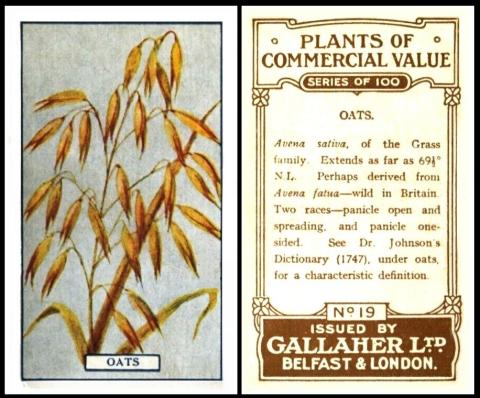
Now we cannot talk about porridge without talking of oats, which were one of the first cereals cultivated by man - in ancient China and Greece. And it was the Greeks who were the first to turn them into a mash that was very like our current porridge. However the original home of the wild oat came from the Near East, just like wheat and barley; but for some reason the oats were cultivated for food much later than those. We do not know why this was, perhaps it was simply that one of them did not grow so well and they bulked it out with the oat, just as a test. Or maybe the oat does not look much, when compared to the wheat and barley, which have larger husks.
A run of bad weather could also have caused its chance to shine, for the Summer County Margarine un-numbered set of "Countryside Cards" (issued in 1975) tells us that "This hardy crop does well in poor conditions and is therefore of particular value in the wetter, hilly areas of Northern England and Scotland". It also says that 90% of the crop is used for animal food, and that it has a secondary usefulness because the straw can be used to feed them too.
And their hardiness is well illustrated on John Player`s "Struggle for Existence", (1923), card 25, where the front shows how if you plant them too deep they will just produce roots further up the stem at the point where it ought to have been.
Anyway oats arrived in the British Isles with the Anglo-Saxons, about 600 AD, so it must have come through Europe with the Saxon side. As it says on our card, the oat, in this case the common oat, or Avena Sativa, is actually a form of grass, and importantly, it can be eaten by human and animal alike; in fact you will find it depicted as `sprouting oats for poultry` on card no.7 of Ogden`s "Poultry Rearing and Management" (1923). This is also mentioned on the Summer County Margarine set, where it says 90% of the crop is used for animal food, and that it has a secondary usefulness because the straw can be used to feed them too.
As an added bonus, card 16 of John Player`s "Products of the World" (1908) shows us a map of the world that demonstrates how far oats had spread. The red on the map shows the current cultivation, in America and Canada, the tip of Africa, mid Spain, the British Isles, Europe and Russia. To this day, Russia remains the chief producer of oats. The reverse of the card says that "..in Great Britain oats are cultivated to double the extent of wheat." It also adds that "The finest oats are grown in Scotland."
Our card is unusual because it was re-issued in 1923. Our original Gallaher reference book (RB.4, issued in 1944), describes them as :
1917. 100 PLANTS OF COMMERCIAL VALUE. (titled series). Size 2 1/2" x 1 1/2". Numbered 1-100. Fronts printed in three colours by letterpress from screen blocks, blue marginal lines, white margins and titles set in a white panel. Backs printed in brown, with descriptions and "Issued by Gallaher Ltd. London."
1923. 100 PLANTS OF COMMERCIAL VALUE. (titled series). Similar to the above and a reprint. The main difference can be seen on the backs of the cards which is whiter and more "polished". The brown printing is also in a somewhat lighter shade. Cards are also known on a blue-grey (bleute) tinted board. Both sets of "Plants of Commercial Value" printed by Tillotsons Ltd. Bolton. Plain back cards are known to exist, but it is thought these are proofs and that no unprinted backs were packed with cigarettes.
By the time of our World Tobacco Issues Index, this set appears under section 3 of the Gallaher issues only, which covers issues 1921-29, and omits any reference to those 1917 cards, even though, as it says above, they were distinctly different. This description, and, by the way, it is identical in the updated World Tobacco Issues Index, purely says : "PLANTS OF COMMERCIAL VALUE. Sm. Nd. (100)"
